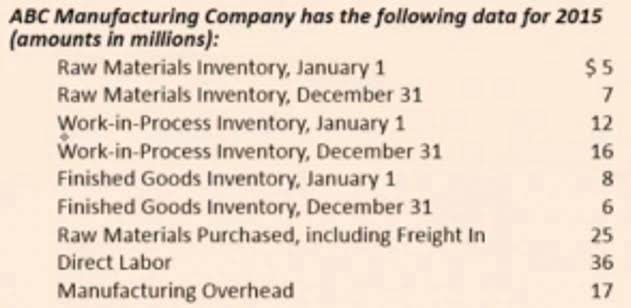Unearned revenue from the money you have yet to receive for services or products that you have not yet delivered is considered a liability. For the past 52 years, Harold Averkamp (CPA, MBA) hasworked as an accounting supervisor, manager, consultant, university instructor, and innovator in teaching accounting online. He is the sole author of all the materials on AccountingCoach.com. To learn more about the balance sheet, see our Balance Sheet Outline.
- Apple pays for rent ($600) and utilities ($200) expenses for a total of $800 in cash.
- A company’s quarterly and annual reports are basically derived directly from the accounting equations used in bookkeeping practices.
- The cost of this sale will be the cost of the 10 units of inventory sold which is $250 (10 units x $25).
- Part of the basics is looking at how you pay for your assets—financed with debt or paid for with capital.
- Often, a company may depreciate capital assets in 5–7 years, meaning that the assets will show on the books as less than their “real” value, or what they would be worth on the secondary market.
A debit refers to an increase in an asset or a decrease in a liability or shareholders’ equity. A credit in contrast refers to a decrease in an asset or an increase in a liability or shareholders’ equity. The Accounting Equation is a vital formula to understand and consider when it comes to the financial health of your business. The accounting equation is a factor in almost every aspect of your business accounting. Obligations owed to other companies and people are considered liabilities and can be categorized as current and long-term liabilities. The business has paid $250 cash (asset) to repay some of the loan (liability) resulting in both the cash and loan liability reducing by $250.
Example Transaction #3: Purchase of Supplies on Credit
Because there are two or more accounts affected by every transaction, the accounting system is referred to as the double-entry accounting or bookkeeping system. Income and expenses relate to the entity’s financial performance. Individual transactions which result in income and expenses being recorded will ultimately result in a profit or loss for the period.
Accounting Equation Formula and Calculation
The revenue a company shareholder can claim after debts have been paid is Shareholder Equity. Taking time to learn the accounting equation and to recognise the dual aspect of every transaction will help you to understand the fundamentals of accounting. Whatever happens, the transaction will always result in the accounting equation balancing. The inventory (asset) of the business will increase by the $2,500 cost of the inventory and a trade payable (liability) will be recorded to represent the amount now owed to the supplier. Each example shows how different transactions affect the accounting equations. If your business has more than one owner, you split your equity among all the owners.
Examples of the Accounting Equation
Shareholders’ equity comes from corporations dividing their ownership into stock shares. Owners’ equity typically refers to partnerships (a business owned by two or more individuals). The CFS shows money going into (cash inflow) and out of (cash outflow) a business; it is furthermore separated into operating, investing, and financing activities. Think of retained earnings as savings, since it represents the total profits that have been saved and put aside (or “retained”) for future use. Shaun Conrad is a Certified Public Accountant and CPA exam expert with a passion for teaching. After almost a decade of experience in public accounting, he created MyAccountingCourse.com to help people learn accounting & finance, pass the CPA exam, and start their career.
Speakers, Inc. purchases a $500,000 building by paying $100,000 in cash and taking out a $400,000 mortgage. This business transaction decreases assets by the $100,000 of cash disbursed, increases assets by the new $500,000 building, and increases liabilities by the new $400,000 mortgage. As you can see, assets equal the sum of liabilities and owner’s equity. This makes sense when you think about it because liabilities and equity are essentially just sources of funding for companies to purchase assets.
It is used to transfer totals from books of prime entry into the nominal ledger. Every transaction is recorded twice so that the debit is balanced by a credit. A company’s quarterly and annual reports are basically derived directly from the accounting equations used in bookkeeping practices. These equations, entered in a business’s general ledger, will provide the material that eventually makes up the foundation of a business’s financial statements. This includes expense reports, cash flow and salary and company investments. The accounting method under which revenues are recognized on the income statement when they are earned (rather than when the cash is received).
Drawings are amounts taken out of the business by the business owner. Get instant access to lessons taught by experienced private equity pros and bulge bracket investment bankers including financial statement modeling, DCF, M&A, LBO, Comps and Excel Modeling. Apple pays for rent ($600) and utilities ($200) expenses for a total of $800 in cash. We use owner’s equity in a sole proprietorship, a business with only one owner, and they are legally liable for anything on a personal level. Debt is a liability, whether it is a long-term loan or a bill that is due to be paid.
Notice that each transaction changes the dollar value of at least one of the basic elements of equation (i.e., assets, liabilities and owner’s equity) but the equation as a whole does not lose its balance. So, now you know how to use the accounting formula and what it does for your books. The accounting equation is important because it can give you a clear picture of your business’s financial situation. It is the standard for financial reporting, and it is the basis for double-entry accounting. Without the balance sheet equation, you cannot accurately read your balance sheet or understand your financial statements.
The income statement reports the revenues, gains, expenses, losses, net income and other totals for the period of time shown in the heading of the statement. If a company’s stock is publicly traded, earnings per share must appear on the face of the income statement. The income statement is the financial statement that reports a company’s revenues and expenses and the resulting net income. While the balance sheet is concerned with one point in time, the income statement covers a time interval or period of time.
This bank reconciliation adjustments in xero business transaction increases company cash and increases equity by the same amount. It’s important to note that although dividends reduce retained earnings, they are not expenses. Therefore, dividends are excluded when determining net income (revenue – expenses), just like stockholder investments (common and preferred). In accounting, we have different classifications of assets and liabilities because we need to determine how we report them on the balance sheet. The first classification we should introduce is current vs. non-current assets or liabilities.
It can be found on a balance sheet and is one of the most important metrics for analysts to assess the financial health of a company. Due within the year, current liabilities on a balance sheet include accounts payable, wages or payroll payable and taxes payable. Long-term liabilities are usually owed to lending institutions and include notes payable and possibly unearned revenue. In this form, it is easier to highlight the relationship between shareholder’s equity and debt (liabilities). As you can see, shareholder’s equity is the remainder after liabilities have been subtracted from assets. This is because creditors – parties that lend money such as banks – have the first claim to a company’s assets.
The capital would ultimately belong to you as the business owner. Now that we have a basic understanding of the equation, let’s take a look at each accounting equation component starting with the assets. The balance sheet equation answers important financial questions for your business. Use the balance sheet equation when setting your budget or when making financial decisions. However, due to the fact that accounting is kept on a historical basis, the equity is typically payback period formula not the net worth of the organization.






 When Time Got Louder
When Time Got Louder Spinning Out (2020)
Spinning Out (2020)